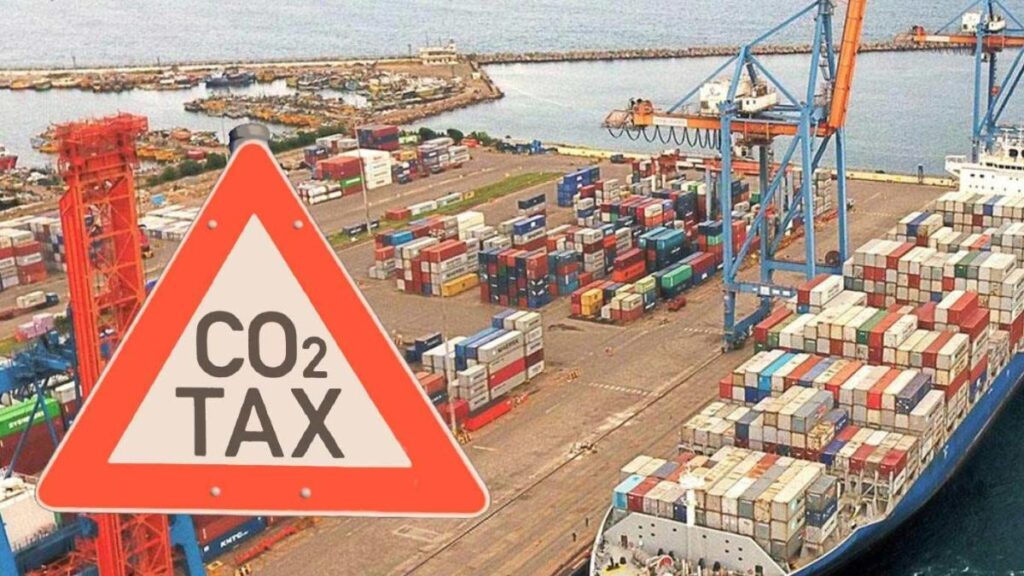Context: World’s first-ever global carbon tax has been imposed on the commercial shipping industry.
Global Carbon Tax on Shipping: A Historic Step Towards Greener Seas
What’s Happening?
India, along with 62 other countries, has voted in favor of the world’s first global carbon tax on the shipping industry. The move was initiated by the International Maritime Organization (IMO) — the United Nations’ specialized agency for regulating shipping.
Key Details
Effective Year: 2028
Mechanism: Ships must either shift to low-emission fuels or pay a carbon fee based on their emissions.
Revenue Potential: The tax could raise up to $40 billion by 2030.
Adopted At: IMO headquarters, London.
Why It Matters
Emission Reduction: Shipping contributes nearly 3% of global greenhouse gas emissions.
Environmental Impact: The carbon tax is expected to accelerate decarbonisation in the maritime sector.
Technology Shift: It encourages the adoption of cleaner, sustainable technologies in global shipping operations.
Significance
This is a landmark move in the global fight against climate change — marking the first-ever carbon pricing mechanism for a major international industry. It sets a precedent for other high-emission sectors to follow suit.

Global Carbon Tax on Shipping: A Historic but Contested Milestone
Background
In a landmark decision, 63 countries, including India, voted in favor of the world’s first global carbon tax on shipping, introduced by the International Maritime Organization (IMO). The goal is to cut greenhouse gas emissions in maritime transport, which currently contributes nearly 3% of global emissions.
Starting 2028, ships will either need to adopt lower-emission fuels or pay a carbon fee. The initiative could raise up to $40 billion by 2030, exclusively for decarbonising the maritime sector.
Criticism of the Agreement
Despite being hailed as historic, the agreement has attracted significant criticism from various countries and advocacy groups:
1. Exclusion of Climate Finance
All revenue will be used only within the shipping industry to support decarbonisation.
Over 60 countries — primarily from the Pacific, Caribbean, Africa, and Central America — had pushed for a portion of the funds to be allocated to broader climate finance, especially for vulnerable nations already facing the brunt of climate change.
2. Inadequate Emissions Reduction
The carbon pricing mechanism is projected to cut shipping emissions by only 10% by 2030, far below the IMO’s own target of at least 20%.
Critics argue that the measure lacks the urgency and ambition required to meet global climate goals.
3. Lack of Transparency and Equity
Countries like Tuvalu, representing Pacific Island nations, voiced strong concerns over a non-transparent negotiation process.
The deal, they argue, fails to promote a “just transition” — one that fairly supports vulnerable countries and communities impacted by climate policies.
About the IMO (International Maritime Organization)
The IMO is a specialized UN agency responsible for regulating international shipping. Established to ensure safety, security, and environmental sustainability in maritime transport, the IMO plays a central role in setting global standards.
Key Functions & Objectives:
Safety and Security:
Sets rules for ship design, construction, operation, and crew certification to enhance maritime safety.Environmental Protection:
Regulates pollution from ships, addresses emissions, ballast water, and hazardous waste management.Legal Frameworks:
Oversees maritime legal issues, including liability, salvage, and accident regulations.Technical Cooperation:
Assists developing countries through training, capacity-building, and technology transfer to improve maritime capabilities.
Membership:
175 Member States (including India).
Open to all UN member states under the IMO Convention.
